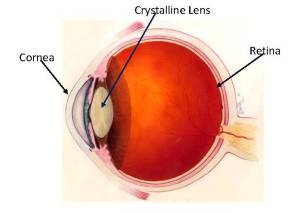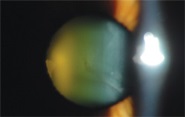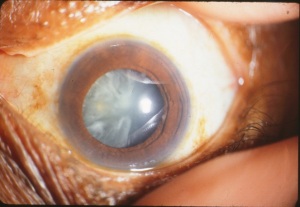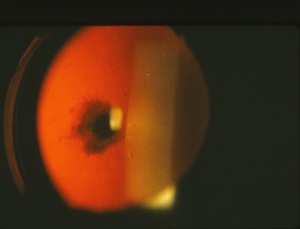 What is a cataract? Are there different types? Why does it form? What are the symptoms? What can you do about it? All good questions that eye doctors get asked on a near daily basis. Today on Eye to the Future we will seek to answer these and more as we demystify Cataracts.
What is a cataract? Are there different types? Why does it form? What are the symptoms? What can you do about it? All good questions that eye doctors get asked on a near daily basis. Today on Eye to the Future we will seek to answer these and more as we demystify Cataracts.
A cataract is the most common ocular disease that results in decreased vision and usually occurs from the normal aging of our eyes. Inside our eyes, we have a clear, round lens (left) that is used to focus light onto the retina. When this lens is clear the light passes easily through.
Over time, however, this lens becomes cloudy and yellowed resulting in a cataract. This change results in two problems: First, the amount of light that is able to pass through the cloudy lens is decreased so the eye continues to need more and more light to function. Second, the light that is able to pass through the cloudy lens bounces off the cloudy areas and is scattered, resulting in increased glare and starbursts around lights.
Common symptoms that are observed when a person has a cataract include: generalized blurry vision, difficulty distinguishing colors, glare (especially at night), difficultly seeing to read books, and having to use more and brighter light to read up close.
Common Types of Cataracts
 Nuclear Sclerotic cataracts are by far the most common and occur from a yellowing of the lens (seen at right). This change is normal and occurs naturally with age, although certain things like smoking can increase the speed of development. Although some yellowing of the human lens is often seen as early as age 50, it usually takes a decade or two for this type of cataract to cause visual problems.
Nuclear Sclerotic cataracts are by far the most common and occur from a yellowing of the lens (seen at right). This change is normal and occurs naturally with age, although certain things like smoking can increase the speed of development. Although some yellowing of the human lens is often seen as early as age 50, it usually takes a decade or two for this type of cataract to cause visual problems.

Cortical cataracts look very similar to spokes on a wagon wheel. These cloudy spokes begin at the outside parts of the lens and grow toward the center causing visual problems. This cataract is also common with age and is highly associated with systemic Diabetes. Cortical cataract also develops more quickly than Nuclear Sclerotic cataracts.

Posterior Subcapsular cataracts are less common. This can be a normal aging change, however this type is most commonly associated with long term oral steroid use or a history of past eye surgery. This type of cataract is a cloudy area on the back of the lens and tends to develop the fastest and cause the most vision problems of all three types.
Treatment of Cataracts
Regardless of the type, when cataracts are first forming it is common to simply monitor them every so often and record their progress. However, over our life time, our cataracts will often get to the point that light is no longer able to get through that clouded lens, resulting in permanently decrease vision. Furthermore, there is little that new glasses will help with, because the problem is inside the eye. At this point, the only option available to improve vision is cataract surgery.
I hope this has dispelled some myths about cataracts, next week we will be going into detail on cataract surgery. What is involved? How is it done? What are the risks? We’ll even include a video of an actual surgery!
As always, please do not hesitate to contact me with additional questions and we’ll see you next time!
– Nick Wolf, OD


